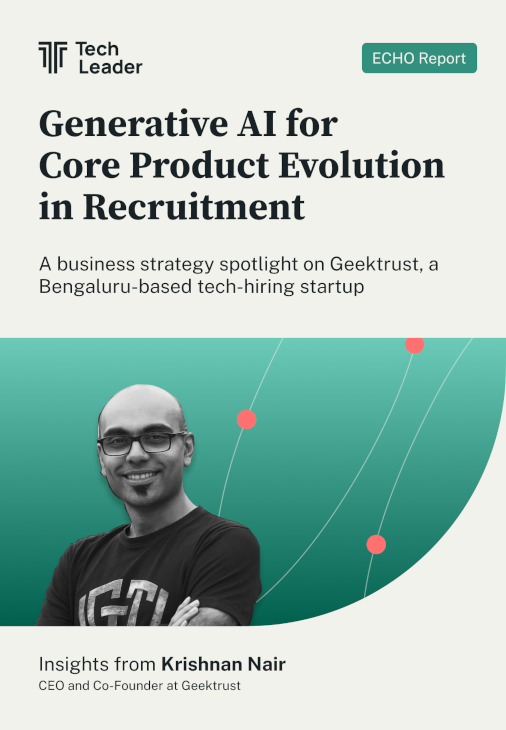Summary
The biggest threat to enterprise AI isn’t hallucination or hype. It’s hesitation. While C-suites wait for perfect strategies and risk-free rollouts, competitors are iterating their way to dominance. TechLeader and Vin Vashishta, Founder and AI Advisor, V- Squared take a closer look at why enterprise AI strategies are stalling, why demos don’t work in the real world and how leading teams are de-risking GenAI, not by playing it safe, but by learning faster than anyone else.
In boardrooms across enterprises, AI strategies are stalling. Not because leaders lack ambition, but because they’re chasing the wrong thing which is certainty.
Ask any Chief AI Officer why their roadmap is blocked, and you’ll hear the usual suspects: data gaps, vendor sprawl, unclear ROI. But beneath it all lies a subtler dysfunction: the belief that you can reason your way into the perfect Gen AI play.
You cannot.
Vin Vashishta, Founder and AI advisor, V- Squared AI, said the enterprise winners aren’t waiting for strategic clarity. They’re shipping, testing, aligning and learning in public. It’s not messy. It’s mandatory.
In his keynote at Packt’s Generative AI in Action Summit 2024, Vin deconstructed the GenAI bubble, not to dismiss it, but to recalibrate how tech leaders pursue value. He unpacked his hard-won playbook for navigating GenAI implementation with realism, urgency, and repeatable outcomes.
TechLeader unpacks what this looks like in practice for decision makers in boardrooms across the world.
Why Do Enterprise AI Strategies Fail?
There’s a paradox at the heart of GenAI: the faster it moves, the less valuable “perfect” strategy becomes. You could spend six months aligning stakeholders on a chat interface only to discover your customer base wants voice. Or worse, they don’t want AI at all. They want outcomes.
Vin added that this is why the most effective GenAI “strategies” today aren’t really strategies in the traditional sense. They’re agile navigation systems built to survive and evolve. “Execution is how you get closer to perfection. You don’t wait,” Vin reiterated.
Be directionally correct, not perfect.

Here’s what directional correctness looks like in practice.
- Right value signal: Start where there’s a clear business or user pain, ideally one with an existing budget line.
- Feasible path: It doesn’t have to be cutting-edge. It has to be buildable, reliable, and testable.
- Tight feedback loop: Get signal quickly. Ship, measure, iterate before the hype cycle resets.
This is a deliberate shift from strategy-led planning to execution-led learning.
Demos Don’t Deliver
Vin admitted, “Demos are easy.”
Enterprise leaders love GenAI demos. Internally, they inspire. Externally, they reassure.
But when you watch these companies convert these demos into products, “they fail miserably,” he added.
This is because demos work in a vacuum, while production doesn’t.
Vin added that businesses fail to distinguish between mere hype and actual reality. While hype promises everything will work perfectly, reality involves acknowledging shortcomings. Successful solutions incorporate mitigations to address problems like hallucination, security vulnerabilities, and data concerns.
He explained this with the example of Perplexity AI, a successful AI engine, iterated to include source verification to mitigate hallucination, whereas Intuit’s tax assistant AI platform failed to take these factors into account, despite being directionally correct.
Vin added that the shift we’re seeing now is from showing potential to designing reliability, which means, intent-aware interfaces over chatbots, toolchains, and mitigation layers.
Contextual Data is the MOAT
Vin mirrors the growing industry consensus that code and models are no longer durable moats.
“Code is no longer a competitive advantage. Data is,” he says.
But not just any data. Contextual data, the kind that captures how work is done, why it was done that way, and what the outcomes were. That’s what Vin calls the real differentiator in enterprise AI.
Read more about how Lucidis AI transformed unstructured data into structured insights resulting in an 80% reduction in work order processing time.
In a landscape where open-source models are replicating top-tier performance at warp speed, the model itself offers a razor-thin monetization window. “The amount of time you have to make money with that best-in-class model… is very, very short,” Vin cautions. Competitors will “iterate behind you and catch up very quickly.”
What kind of data actually compounds?
Vin outlines this in four categories:
- Metadata on user intent
- Workflow traces
- Outcome feedback
- Decision trees and audit trails
This kind of data represents the expertise required to run your business. It doesn’t come from log files or CRM exports. It comes from watching how work actually happens and capturing the context that makes it meaningful.
“If you don’t know what generated the data, the intent, the outcome, it’s not useful. The highest quality data comes from contextual sources.”
And yet, most enterprise data is generic, siloed, and expensive to access. That’s not an advantage but technical debt in disguise.
What is the Fix for Enterprise AI failures?
Vin said the fix lies not in flashy AI features, but with operational discipline:
1. Engineer access to the data you actually need
“We can create engineered data-generating processes,” Vin explains. Even “useless datasets” can become valuable with “a little bit of additional context.”
2. Incentivize contextual capture
Encourage workflows that produce the right metadata. Turn UX friction into data collection moments.
3. Align with customers
“If we start gathering data [customers] don’t want us to, they churn.” Vin points to Apple’s on-device AI as a model: privacy-aligned, cost-efficient, and trust-preserving. “We reduce costs and respect privacy at the same time.”
The Road Ahead
In a fast-evolving space, the ability to execute, adapt, and learn systematically is becoming a more reliable path to competitive advantage than any predefined strategy. Enterprise AI strategies often stall due to over-engineering and delayed execution and not lack of ambition.
For more in-depth insights on enterprise AI, read the TechLeader Enterprise AI Report, where we spoke to 50 senior tech leaders including founders, CTOs and heads of AI on what generative AI means for their business, their teams, and the future of enterprise technology.
FAQs
1. What’s the core reason enterprise AI projects fail quietly?
Not hallucinations or hype—but hesitation. Enterprises are stuck in over-engineered strategies, waiting for perfect conditions while others are already learning by doing.
2. What does “directionally correct” mean in the context of GenAI?
It means starting with a clear value signal, choosing a feasible and testable solution path, and establishing a tight feedback loop. You iterate toward value instead of over-planning for perfection.
3. Why are demos considered traps in enterprise AI and what works instead?
Demos are built in ideal, controlled environments. Real-world deployments require reliability, risk mitigation, and workflow integration. Success comes from intent-aware interfaces, toolchains, and systems designed to handle drift and hallucinations.
4. Isn’t data already a moat for enterprises?
Not if it’s generic, siloed, or hard to access. Competitive advantage lies in contextual data, metadata, workflow traces, outcome feedback, and decision logic that reflect real operational expertise.
5. What mindset and design shifts are needed to succeed with GenAI?
Leaders must realize that strategy follows execution. Design AI products around real workflows and user intent, with fallback mechanisms, privacy alignment, and value-focused iteration.
%20(1).png)



.svg)





.png)




.svg)